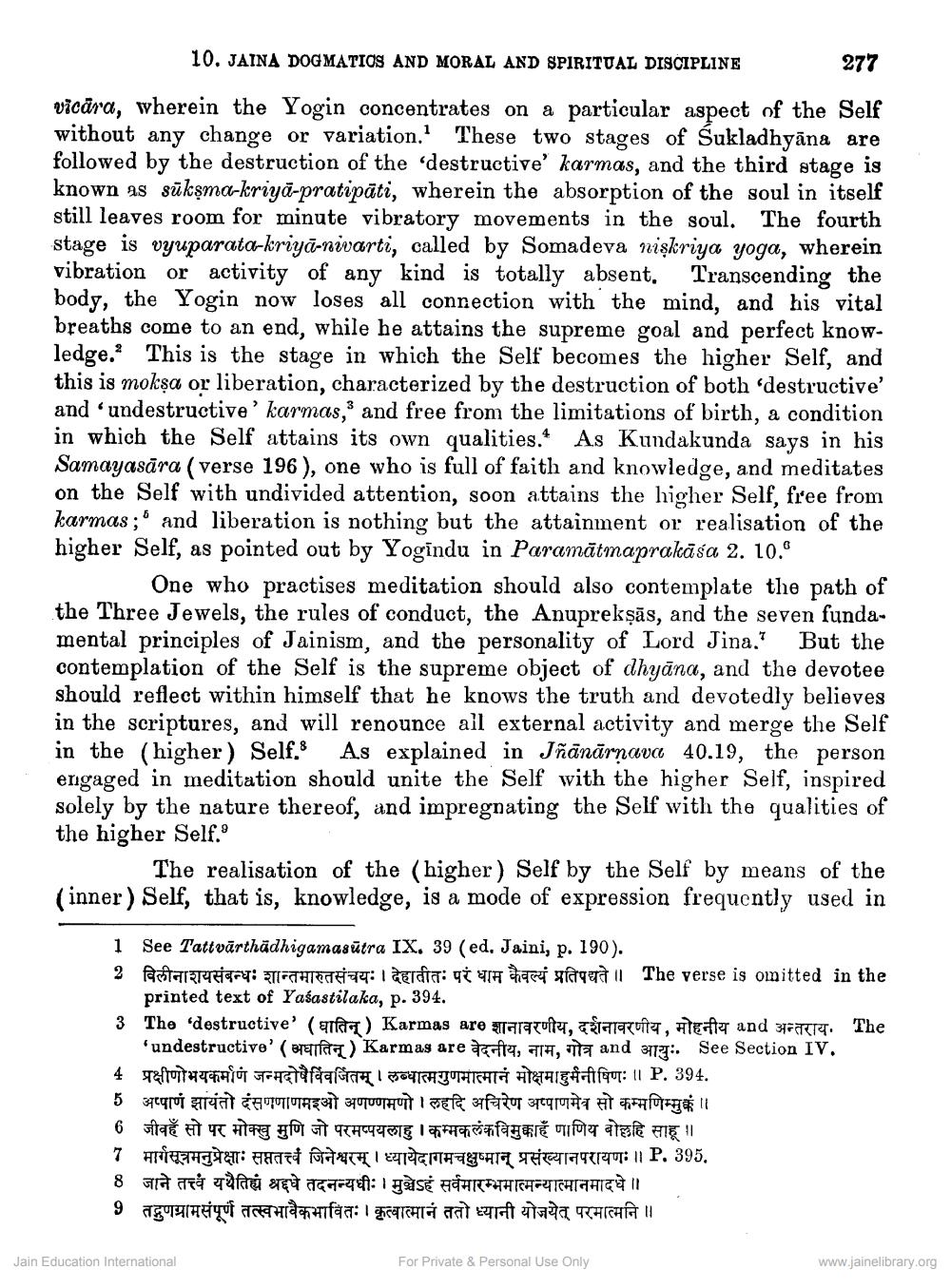________________
10. JAINA DOGMATICS AND MORAL AND SPIRITUAL DISCIPLINE
277
vicāra, wherein the Yogin concentrates on a particular aspect of the Self without any change or variation. These two stages of Sukladhyāna are followed by the destruction of the destructive' karmas, and the third stage is known as sūkşma-kriyā-pratipāti, wherein the absorption of the soul in itself
s room for minute vibratory movements in the soul. The fourth stage is vyuparata-kriyā-nivarti, called by Somadeva nişkriya yoga, wherein vibration or activity of any kind is totally absent. Transcending the body, the Yogin now loses all connection with the mind, and his vital breaths come to an end, while he attains the supreme goal and perfect knowledge. This is the stage in which the Self becomes the higher this is moksa or liberation, characterized by the destruction of both 'destructive' and "undestructive' karmas, and free from the limitations of birth, a condition in which the Self attains its own qualities. As Kundakunda says in his Samayasāra (verse 196), one who is full of faith and knowledge, and meditates on the Self with undivided attention, soon attains the higher Self, free from karmas;and liberation is nothing but the attainment or realisation of the higher Self, as pointed out by Yogindu in Paramātmaprakāśa 2. 10.
One who practises meditation should also contemplate the path of the Three Jewels, the rules of conduct, the Anuprekşās, and the seven fundamental principles of Jainism, and the personality of Lord Jina." But the contemplation of the Self is the supreme object of dhyāna, and the devotee should reflect within himself that he knows the truth and devotedly believes in the scriptures, and will renounce all external activity and merge the Self in the (higher) Self. As explained in Jñānārnava 40.19, the person engaged in meditation should unite the Self with the higher Self, inspired solely by the nature thereof, and impregnating the Self with the qualities of the higher Self.
The realisation of the higher) Self by the Self by means of the (inner) Self, that is, knowledge, is a mode of expression frequently used in
1 See Tattvārthādhigamasūtra IX. 39 (ed. Jaini, p. 190). 2 STATISTICHET: ITIFAHTETHET: 1 Terda: qĖ ECH macar saert The verse is omitted in the
printed text of Yaśastilaka, p. 394. 3 The 'destructive' (घातिन) Karmas are शानावरणीय, दर्शनावरणीय, मोहनीय and अन्तराय. The ___ 'undestructive' (अघातिन् ) Karmas are वेदनीय, नाम, गोत्र and आयुः. See Section IV. 4 tafuta halofarm 154FHITHICHO HAIG#affout: 11 P. 394. 5 अप्पाणं झायंतो दंसणणाणमइओ अणण्णमणो । लहदि अचिरेण अप्पाणमेव सो कम्मणिम्मुक्कं ।। 6 जीवहँ सो पर मोक्खु मुणि जो परमप्पयलाहु । कम्मकलंकविमुक्काहँ णाणिय बोल्लहि साहू । 7 HUHÀHT: HTTÅ ATT I TEMATYCHT THE G ut: 11 P. 395. 8 जाने तत्त्वं यथैतिह्य श्रद्दधे तदनन्यधीः । मुञ्चेऽहं सर्वमारम्भमात्मन्यात्मानमादधे ॥ 9 तद्गुणग्रामसंपूर्ण तत्स्वभावैकभावितः । कृत्वात्मानं ततो ध्यानी योजयेत् परमात्मनि ।
Jain Education International
For Private & Personal Use Only
www.jainelibrary.org




